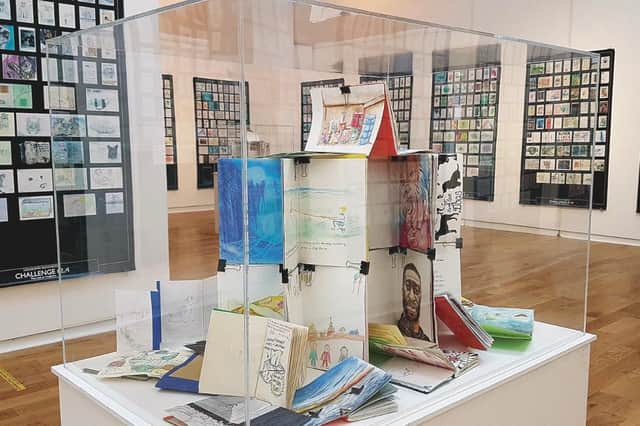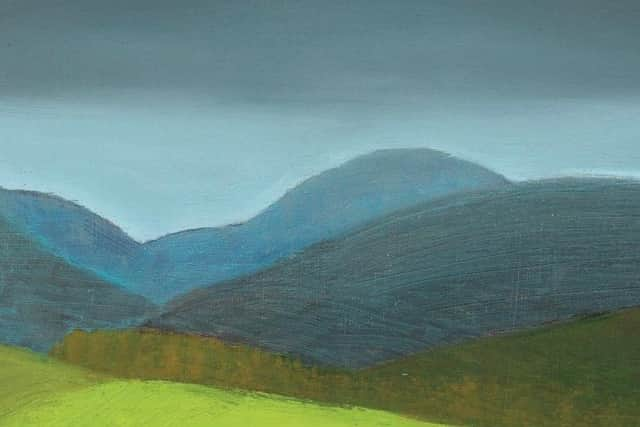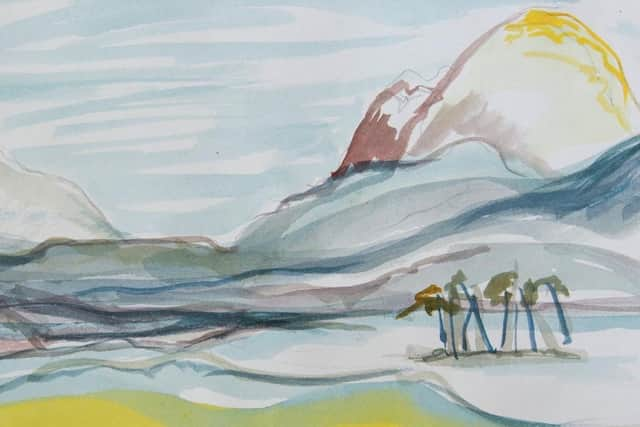Art reviews: Lockdown Sketchbooks at An Lantair | Jane MacNeill at Kilmorack Gallery | Alexander Moffat & Helen Bellany at Junor Gallery


Lockdown Sketchbooks, An Lantair, Stornoway ****
Jane MacNeill: The Silence of Mountains, Kilmorack Gallery, near Beauly ****
A Celebration of Trees, Kilmorack Gallery, near Beauly ****


Alexander Moffat and Helen Bellany, Junor Gallery, St Andrews ****
Advertisement
Hide AdNot long ago I would never have considered reviewing a show that I had not seen. How times have changed. During the extreme period of lockdown the only way to see any art at all was online. The galleries responded by creating online shows and generally putting things online in a much more extensive and sophisticated way than they had ever done previously, or at least those galleries did that had to make living. The public galleries were slower to respond. I won’t say that all that has turned me into an armchair critic, but it does mean that there is now a much fuller and more accessible programme of exhibitions online than there was before, and while public transport is still to be avoided by the prudent, virtual visits to some of the country’s more far-flung galleries are possible.
It is a good few years since I visited An Lanntair in Stornoway for instance, but, online, the gallery’s Lockdown Sketchbooks exhibition is the collected results of a rather remarkable project. At the beginning of lockdown sketchbooks were sent out to over 100 participants. This was then followed up over the course of a month with emails setting a daily challenge. The completed sketchbooks were then sent back and put together into a show. If you can find your way on the An Lanntair website to the “virtual tour” of the exhibition – it’s not that easy, but do persevere – you can see the enormous variety of the results and the evident enthusiasm the project inspired. The challenges included such things as “the middle of the night,” or “the contents the fridge.” There is humour, poetry, a lot of skill and much else in the very diverse results. A selection of the responses from people who have taken part is also included and these are as interesting as the drawings themselves. The whole thing was clearly a big success and at a time when there wasn’t much of that about.
Remote of course is a matter of where you start from. The Kilmorack Gallery doesn’t consider itself remote at all. In a handsome Georgian church a mile or so up Strathglass, it is only half an hour from Inverness, but correspondingly it is quite a long way from the Central Belt. The Silence of Mountains, a collection of Jane MacNeill’s quietly poetic paintings of Scottish mountains, is currently showing. She manages to capture their grand simplicity and at the same time hint at the infinite complexities of changing light and weather without getting bogged down in detail. The result in Winter Mountain with Reflections of Two Clouds (Carn Eilrig), for instance, or Mountain Pass in Red and Blue (Lairig Ghru) is a contemplative tranquility and quiet richness. This show finished in the gallery at the end of August, but remains visible online.


Concurrently, but only online, Kilmorack is also showing A Celebration of Trees. This is its second virtual Ikigai Room. Ikegai is Japanese and means roughly whatever it is that gives your life purpose, a fancy way of saying raison d’être in fact, although put that way the opposite condition, having no raison d’être, does sound rather bleak. Some of the show is also a bit elusive. It’s a room with shifting walls. Suitably for the Japanese theme, it opens with a quotation from the 17th-century Japanese poet, Matsuo Basho, about the wind in the cedars. This is accompanied by a changing sequence of rather beautiful photos of trees, but for the life of me I couldn’t find any reference to the artist responsible.
After that there are 11 artists who are identified, some familiar, others less so. Each is represented by a single, unlabelled work with a link to other images. Ian Westacott, for instance, creates portrait memorials of great trees, especially of the elms on the Black Isle that eventually fell prey to Dutch elm disease. His representative image here is a superb etching of a mighty elm called the Owl Tree. It is a little frustrating, though, that if you click on the image, it takes you to a different etching. You then have to search through his works to find the one you started with.
Robert Powell is another wonderful printmaker. His image in the virtual room is unidentified, but if you read the introduction by gallery owner Tony Davidson you can deduce that the melancholy looking chap sitting with a spade at the foot of a laurel tree is Apollo. The laurel is Daphne after metamorphosis; in Ovid’s story she escaped Apollo’s lecherous clutches by turning into a laurel tree. The identification is really guesswork though, for if you look for the print among Powell’s other works, it isn’t there. The same seems to be true of Allan MacDonald. His fine painting of a yellow tree must remain unidentified. Mark Edward’s Stopping to Watch the Ten O’clock Train is less elusive. Click on it and that’s what you get, two men in hats standing in the snow to watch a steam train pass on a distant viaduct. Three trees seem a little incidental, but it’s a nice homage to Magritte. Ade Adesina’s Let There be Light has her familiar baobab tree standing on the cracked mud of a post-apocalyptic, dried up sea. The artist whose work is least familiar to me here is Duke Christie. Working with wood, he collaborates with his medium. Ash, for instance, is a rectangle of the eponymous wood carved as though its concentric year rings had become waves. Click on it and it leads you to a different work, but that can be forgiven as this substitute is even more striking. Called Dark Star, a circle of black burr elm sits in a field of ash polished so that the woodgrain becomes the dark star’s flaming corona. It is quite beautiful.
Advertisement
Hide AdThe increased presence of the galleries online also means that even closer to home shows that you may have missed are still visible. Alexander Moffat and Helen Bellany have just had a joint show in St Andrews at the Junor Gallery, for instance. Technically it finished at the end of August, but all is not lost for it is still online. Contemporaries at Edinburgh College of Art, Moffat has had a full career as an artist. Helen Bellany cheerfully admits that she took 50 years out married to John Bellany. “Had I been intimidated by the power of John’s work? Most definitely,” she declares, but continues, “Did I resent this? Most definitely not.” Welcome back! The result is a collection of freely painted, sensitive watercolours of scenes in Italy and Scotland. The colour is delicate and there seems to be no hint in them of her late husband’s rhetoric. Hers is a quite different sensibility. Moffat’s subjects are principally mountains, Suilven dark blue against a scarlet sunset, the jagged Apuan Alps in Tuscany pink and blue in the morning light, and – painted from his studio window – Salisbury Crags scarlet in the setting sun.
To see these shows online, visit www.lanntair.com, www.kilmorackgallery.co.uk and www.junorgallery.scot
A message from the Editor:
Advertisement
Hide AdThank you for reading this story on our website. While I have your attention, I also have an important request to make of you.
The dramatic events of 2020 are having a major impact on many of our advertisers - and consequently the revenue we receive. We are now more reliant than ever on you taking out a digital subscription to support our journalism.
To subscribe to scotsman.com and enjoy unlimited access to Scottish news and information online and on our app, visit https://www.scotsman.com/subscriptions
Joy Yates, Editorial Director